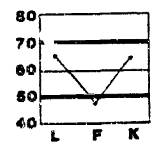

Those involved in the restandardization took steps to maintain continuity between the MMPI and its revision so that the extant research would not be made obsolete. As James Butcher and colleagues, Greene, and others have described, several factors underscored the need to revise the MMPI, including the need for current norms, a larger and more nationally representative normative sample that appropriately included ethnic and racial minorities, and updated item content. After decades of use, the need for restandardization became clear.

McKinley developed the original MMPI by selecting items for inclusion that discriminated a criterion group (i.e., those with a given clinical diagnosis) and comparison groups (i.e., nonpatient normative groups and those with other diagnoses). Through a multistep process, Starke Hathaway and J. Nevertheless, they provide potentially useful information about problem areas, personality types and correlates, and treatment implications. As Roger Greene emphasizes, these descriptions are probabilistic statements based on modal patterns and, as such, do not necessarily describe individuals obtaining a specific code.
Mmpi 2 scoring interpretation code#
In addition to interpretive material linked with individual scale and subscale scores, considerable research has identified and supported descriptions associated with particular patterns of elevations, known as code types, reflecting the 1 to 3 most elevated clinical scales and their combinations. Scales with a T-score of 65 or greater are considered clinically significant. Raw scores on these scales are transformed to norm-based T-scores (mean = 50, standard deviation = 10) to enhance the interpretability of results. The test includes multiple validity indices, assessing test-taking attitudes and approach 10 basic, numbered clinical scales (1 = Hypochondriasis, 2 = Depression, 3 = Hysteria, 4 = Psychopathic Deviate, 5 = Masculinity-Femininity, 6 = Paranoia, 7 = Psychasthenia, 8 = Schizophrenia, 9 = Hypomania, 0 = Social Introversion, with all but scales 5 and 0 considered core clinical scales) and their subscales as well as more than five dozen content scales (e.g., Antisocial Practices, Anxiety), content component scales (e.g., Negative Treatment Indicators: Low Motivation), personality psychopathology trait scales (e.g., Aggressiveness, Negative Emotionality/Neuroticism), and supplementary scales (e.g., Addiction Potential, Overcontrolled-Hostility). First published in 1942 and revised in 1989, the instrument yields a wealth of clinical data and is used across multiple clinical and medical settings, for employment screening and selection, and in a variety of forensic situations. Using 567 true-false items, the MMPI-2 assesses a diverse range of personality characteristics symptoms of psychopathology and patterns of behavior, attitudes, and concerns. The original Minnesota Multiphasic Personality Inventory (MMPI) and its successor have been recognized as the most widely used and researched objective clinical personality inventories.


 0 kommentar(er)
0 kommentar(er)
